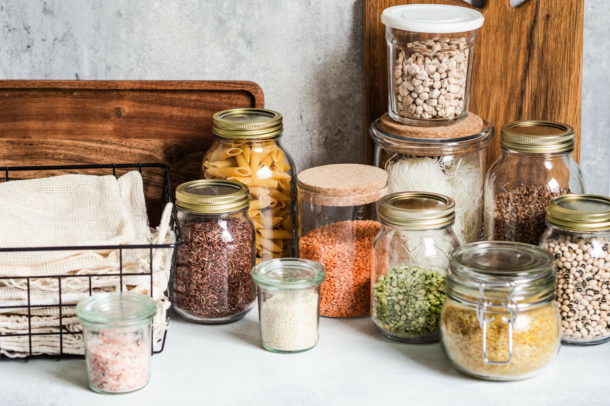Submitted by Megan Dowling, Registered Dietitian
Finding the time and energy to prepare healthy and nutritious meals can be challenging, especially with the added dietary requirements that come with chronic kidney disease. One way to make this feel less intimidating is to take advantage of your pantry and keep it stocked with foods that will make your kidneys happy. Not only does this take some of the time and thinking out of preparing your meals, but it can also help with cost and decrease the amount of trips to the grocery store.
Here are a few examples of kidney friendly pantry items that you can stock up on:
Breads, Cereals and Starches
Breads, cereals, and starches are often a staple in any pantry. To optimize your fibre intake, choose whole grains rather than refined (white) grains more often. This includes things such as barley, brown rice, buckwheat, bulgur, couscous, millet, oatmeal, quinoa, and wild rice.
TIP: Know your labels! Compare sodium content between products and watch out for items with phosphate additives. Talk to your renal dietitian if you have questions about incorporating whole grains into your diet.
Fruits and Vegetables
Canned fruits and vegetables are a budget-friendly option and are just as nutritious as fresh fruits and vegetables. They are convenient, shelf stable and take little time to prepare.
TIP: When buying canned vegetables choose no salt added or drain and rinse them thoroughly under cold water. For fruit, look for those that are canned in water instead of fruit juice or syrup.
Plant-Based Protein
Plant-based proteins such as beans and legumes are low in saturated fat and loaded with fiber. Not only are they beneficial to your health, but they are also non-perishable and easy on your wallet. Canned beans and legumes are convenient and ready to use. Simply drain, rinse, and add to soup, salad, stir fry, chili, casserole, and sauces.
TIP: Got gas? You may notice some extra gas when introducing beans and legumes into your diet. Start slow and gradually add them to your meals. The more you eat them, the less gas is produced.
Nuts and Seeds
Nuts and seeds are a great way to add crunch and flavor to foods. They provide us with protein, fibre, and healthy fats. Try adding unsalted nuts and seeds to salad, smoothies, trail mix, dips, and baked goods.
TIP: To build even more flavour try roasting nuts on a non-stick frying pan until browned and fragrant.
Herbs and Spices
Herbs and spices are your friend! These are excellent ways to enhance the flavor, colour and aroma of food without adding fat, salt, or sugar. Beware of salt substitutes that contain potassium chloride.
TIP: To boost flavor even more, try toasting spices and rubbing herbs in your hand before adding to a recipe.
Oils
Oils are often used while cooking and can be added to many dishes such as salad dressing and pasta. When cooking or adding oil to dishes be sure to use unsaturated fats most often.
TIP: Oils that come from animal sources are saturated fats, except for fish oil. Oils that come from plant sources are unsaturated fats, except for coconut oil and palm oil.
